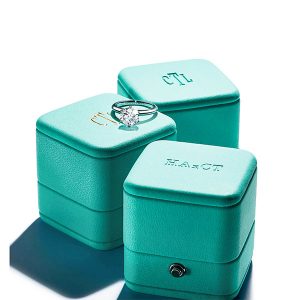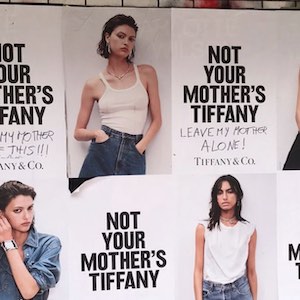
LVMH has done an incredible job reviving the Tiffany & Co. brand. Just ask it.
In a recent conference call, chairman Bernard Arnault was not shy about claiming credit for the retailer’s “remarkable” results since it purchased the company in January 2021. (The luxury conglomerate doesn’t provide specific results for its brands.)
In recent years, as the luxury sector has shown tremendous growth, “Tiffany stagnated,” Arnault announced. “Both profit and revenue were flat. … We were able to turn it around and bring it up to extremely high performance.”
Perhaps. Then again, the jewelry industry as a whole has underperformed the luxury sector for years. That is, until 2021—when it outperformed just about every category.
In fact, last year was so great for the jewelry biz, it would be remarkable if Tiffany didn’t do remarkably. While the new Tiffany team has undoubtedly worked hard at boosting the brand, we may have to wait for a more normal time before we can truly gauge the new team’s success. (The company declined to make an executive available for this story.)
So far, LVMH’s tenure has been wild and a little tumultuous. Some longtime vets have left—not just in the C-suites but a few levels down.
LVMH, meanwhile, is following its standard playbook and taking the brand upscale. Execs plan to focus on less on cheap silver, more on “high-end sparkling jewelry,” according to a Reuters report of a Tiffany town hall.
All of which has caused a huge culture shift—and sometimes culture clash. Not everyone believes the LVMH playbook will play here. While the brand has always had a high-toned image, it still carried a large amount of accessible product. In 2017, the Wall Street Journal reported that “45% of Tiffany’s sales last year came from jewelry categories with an average price of $530 or less.”
“[T]he magic of Tiffany’s lies in its ability to make the ordinary person feel extraordinary,” the Associated Press said in 1998, when the store sold playing-card decks for $12.50.
But now that’s changed.
“It used to be a very warm, open place,” says a former insider. “It’s become more exclusive. When you see the new store design in Boston, you wouldn’t think people would want to spend $200 in there.”
This person admits that, in the past, the brand may have needed more polish, but now says, “the question is, how far do you go with that?”
That points to LVMH’s difficult balancing act. Tiffany has traditionally attracted younger consumers with low-price-point designer silver jewelry. Those shoppers often become lifelong consumers.
It still hopes to attract a younger crowd—and also a richer one. That makes sense in markets like China, where young consumers spend more than their parents. But in America, being young often means being saddled with college debt, and some millennials frown on ostentation. And Tiffany has always been a very American brand.
In a Wall Street Journal article earlier this month, Alexandre Arnault, the brand’s executive vice president of product and communications (and Bernard’s son), denied that LVMH wanted to “de-Americanize” the company, noting that when it acquires a company—and it’s bought dozens—it tries to respect the brand’s DNA. Still, it was his father who said he wanted make Tiffany “a little bit French.”
To be fair, Tiffany has long looked abroad for inspiration. Its current CEO, Anthony Ledru, is its third European CEO in a row (excluding Mike Kowalski’s brief return). This is also not the first time the brand has tried to move upscale.
But the Arnaults have put their feet on the gas. Take its marketing. Tiffany has historically used celebrities in its ads. In 2017, it snagged Lady Gaga. Post-acquisition, LVMH has not only signed up Beyoncé and Jay-Z, but also Kim Kardashian, Pharrell, Rosé, Sarah Jessica Parker, Anya Taylor-Joy, Tracee Ellis Ross, and Eileen Gu.

Its new ads don’t just show off the celebrities’ talent, but their wealth. Pre-acquisition, A$AP Ferg and Elle Fanning danced to Moon River in their street clothes. (They probably weren’t cheap street clothes, but still.) Post-LVMH, Beyoncé sang the song in formal wear at a grand piano.
The ad frequency has changed too. Past Tiffany marketing decisions were slow and considered. Now, we see much more marketing, much more often.
That’s been both good and bad. The old regime handled the brand with extreme delicacy, like it was a piece of its famed crystal. But in the year that LVMH has run Tiffany, it has stumbled into an amazing list of controversies. There was the Beyoncé blood diamond kerfuffle. The backlash over “Not Your Mother’s Tiffany.” Jean-Michel Basquiat’s friends decrying its use of his artwork. Now, comes a new charge: Tiffany glasses worn by Pharrell are just copies of an old pair sold by Sotheby’s.

These flare-ups weren’t big blunders—more like tone-deaf goofs—and it’s arguable whether they deserved all the attention they got. But that’s quite a list.
None of this means doom. As this insightful piece explains, in the so-called attention economy, bad press can sometimes—though not always—be a boon. Brands generally don’t seek negative attention. But social media firestorms have become so frequent that they’re quickly forgotten, as Twitter hordes move to the next target of the day. Meanwhile, the brand’s profile gets a boost. Tiffany got a lot of press coverage in the past year, and, while a surprising amount of it was negative, it was still press.
So while Alexandre Arnault admitted the “Not Your Mother’s Tiffany” campaign caused a backlash, he added, “it also had people who had never thought of Tiffany talk about us, which I view as a good sign.”
Tiffany doesn’t seem to be deliberately courting controversy; it tries to stamp out these fires rather quickly. (It usually doesn’t even comment.) The Beyoncé diamond issue ended with “a source” saying the singer was “disappointed and angry” at the retailer—though, apparently, not disappointed or angry enough to walk away from her contract. “Not Your Mother’s Tiffany” was scrapped after less than two weeks.
“The brand is looked at with binoculars and sniper guns,” Arnault told the Journal. “It’s quite fascinating to see the level of engagement we have, either on the hate side or the love side.”
All this has increased the buzz around Tiffany. It wants to be talked about, and it is.
After a year, it’s clear that LVMH has boosted engagement, and, more importantly, investment. It has laid out a clear plan going forward, one it knows how to execute, and while some think that strategy might not be totally appropriate for Tiffany, at least it’s a plan.
Yet, when I speak to Tiffany vets and other onlookers, they note that, with a few exceptions, neither the product, nor the overall retail experience, has changed significantly. The ads might have said this is “not your mother’s Tiffany,” but for now, most moms would probably recognize the place.
“Changing the product and collection will be absolutely essential,” another former insider says. ”They will about need a good 18 months to get new product to market. Tiffany is a supertanker, it’s not a speed boat.”
LVMH “won’t get it right immediately,” this person adds. “But I’m optimistic about the long-term.”
(Photo courtesy of Tiffany & Co.)
Follow JCK on Instagram: @jckmagazineFollow JCK on Twitter: @jckmagazine
Follow JCK on Facebook: @jckmagazine





